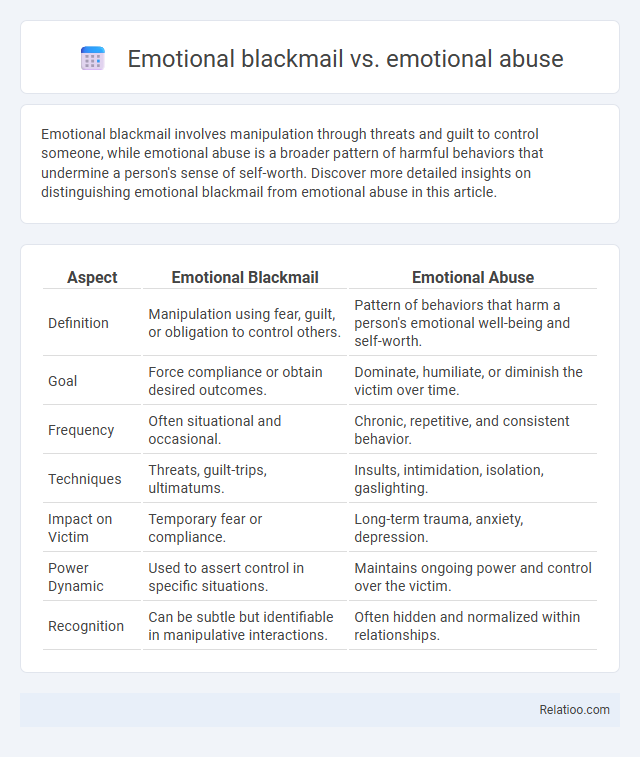Emotional blackmail involves manipulation through threats and guilt to control someone, while emotional abuse is a broader pattern of harmful behaviors that undermine a person's sense of self-worth. Discover more detailed insights on distinguishing emotional blackmail from emotional abuse in this article.
Table of Comparison
| Aspect | Emotional Blackmail | Emotional Abuse |
|---|---|---|
| Definition | Manipulation using fear, guilt, or obligation to control others. | Pattern of behaviors that harm a person's emotional well-being and self-worth. |
| Goal | Force compliance or obtain desired outcomes. | Dominate, humiliate, or diminish the victim over time. |
| Frequency | Often situational and occasional. | Chronic, repetitive, and consistent behavior. |
| Techniques | Threats, guilt-trips, ultimatums. | Insults, intimidation, isolation, gaslighting. |
| Impact on Victim | Temporary fear or compliance. | Long-term trauma, anxiety, depression. |
| Power Dynamic | Used to assert control in specific situations. | Maintains ongoing power and control over the victim. |
| Recognition | Can be subtle but identifiable in manipulative interactions. | Often hidden and normalized within relationships. |
Understanding Emotional Blackmail
Emotional blackmail involves manipulating someone by exploiting their fears, guilt, or sense of obligation to control their behavior, often using threats or ultimatums. Unlike general emotional abuse, which encompasses a broader range of manipulative behaviors that degrade or belittle, emotional blackmail specifically pressures victims into compliance through psychological coercion. Understanding emotional blackmail is crucial for recognizing patterns of control and protecting mental health in interpersonal relationships.
Defining Emotional Abuse
Emotional abuse involves patterns of behavior that systematically undermine a person's self-worth through manipulation, humiliation, and control tactics that cause psychological harm. Emotional blackmail is a specific form of emotional abuse where threats, guilt, or fear are used to coerce compliance or control. Understanding emotional abuse requires recognizing behaviors that erode mental well-being beyond isolated incidents, involving sustained psychological manipulation and coercion.
Key Differences Between Emotional Blackmail and Emotional Abuse
Emotional blackmail involves manipulating someone through fear, guilt, or obligation to control their behavior, whereas emotional abuse encompasses a broader pattern of behaviors that harm a person's emotional well-being, including constant criticism, humiliation, and intimidation. Key differences between emotional blackmail and emotional abuse include intent and scope: emotional blackmail is a tactic used within emotional abuse to coerce compliance, while emotional abuse includes various forms of ongoing psychological harm beyond manipulation. Recognizing these distinctions is crucial for identifying appropriate interventions and support for victims.
Common Tactics in Emotional Blackmail
Emotional blackmail commonly involves tactics such as guilt-tripping, threats, and manipulation to control or influence another person's behavior. Unlike general emotional abuse, which can include a broad range of harmful behaviors like sarcasm, humiliation, or isolation, emotional blackmail specifically uses fear and obligation to enforce compliance. Recognizing these tactics helps differentiate emotional blackmail from other forms of emotional abuse and is essential for effective intervention.
Recognizing Patterns of Emotional Abuse
Recognizing patterns of emotional abuse involves identifying consistent behaviors such as manipulation, intimidation, and control aimed at undermining an individual's autonomy and self-worth. Emotional blackmail specifically uses threats, guilt, and fear to coerce someone into compliance, often exploiting vulnerabilities for personal gain. Distinguishing emotional blackmail from broader emotional abuse requires attention to recurring tactics like silent treatment, blame-shifting, and ultimatums that erode emotional stability over time.
Psychological Impact on Victims
Emotional blackmail involves threats or manipulation to control someone's behavior, causing victims to experience anxiety and diminished self-worth. Emotional abuse encompasses a broader range of harmful behaviors, including constant criticism and humiliation, which can lead to long-term psychological trauma and depression. Your mental health may suffer significantly when subjected to these toxic dynamics, requiring awareness and support to heal from their deep psychological impact.
Signs You Might Be Experiencing Emotional Blackmail or Abuse
Signs you might be experiencing emotional blackmail or abuse include feeling manipulated through guilt, fear, or obligation to comply with someone's demands. Your self-esteem may erode as the abuser consistently undermines your feelings, imposes control, and creates a sense of helplessness. Recognizing repeated threats, ultimatums, and emotional coercion is crucial to identifying and addressing these harmful behaviors.
Why People Use Emotional Manipulation
Emotional blackmail and emotional abuse both involve manipulative tactics aimed at controlling others by exploiting their feelings, but emotional blackmail specifically relies on threats and fear to coerce compliance, whereas emotional abuse encompasses a broader range of harmful behaviors including constant criticism and intimidation. People use emotional manipulation to gain power and control in relationships, often exploiting your vulnerabilities and insecurities to maintain dominance and avoid accountability. Understanding these distinctions helps protect your emotional well-being by recognizing when manipulation is at play and learning to set healthy boundaries.
Steps to Protect Yourself from Emotional Blackmail and Abuse
Recognizing emotional blackmail involves identifying manipulative tactics such as guilt-tripping, threats, and coercion aimed at controlling behavior, while emotional abuse encompasses ongoing patterns of verbal and psychological harm that undermine self-esteem. Steps to protect yourself from emotional blackmail and abuse include setting clear boundaries, seeking support from trusted friends or professionals, and practicing assertive communication to resist manipulation. Prioritizing self-care and documenting incidents can also empower victims to regain control and pursue psychological healing or legal action if necessary.
Seeking Help: Resources and Recovery Options
Seeking help for emotional blackmail, emotional abuse, and similar manipulative behaviors involves accessing specialized resources such as counseling services, support groups, and legal aid that focus on mental health and personal safety. Your recovery options include therapy modalities like cognitive-behavioral therapy (CBT) and trauma-informed care, which aid in rebuilding self-esteem and establishing healthy boundaries. Numerous national and local organizations provide educational materials, crisis hotlines, and safe shelter programs to support survivors on their path to healing and empowerment.

Infographic: Emotional blackmail vs Emotional abuse
 relatioo.com
relatioo.com